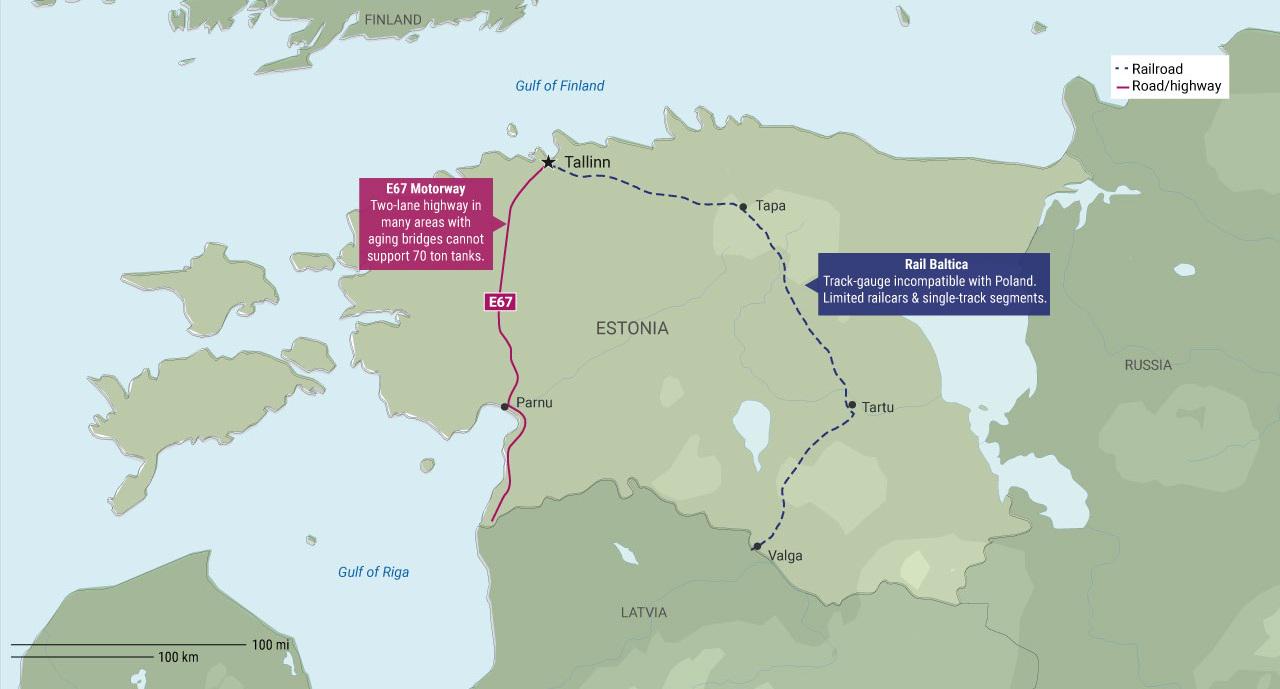Estonia Infrastructure Challenges for NATO Map


Alex Cartwright
Senior Cartographer & GIS Specialist
Alex Cartwright is a renowned cartographer and geographic information systems specialist with over 15 years of experience in spatial analysis and data...
Geographic Analysis
What This Map Shows
The "Estonia's Infrastructure Pain Points for NATO" map by Delphi Global provides a comprehensive visualization of the critical infrastructure vulnerabilities in Estonia that could impact NATO's operational capabilities. This map highlights various infrastructure elements such as transportation routes, energy supply lines, and communication networks, all of which are crucial for military logistics and troop movement. By outlining these vulnerabilities, the map serves as a strategic tool for understanding how well equipped Estonia is to support NATO forces in times of crisis.
Transitioning from the visualization, the focus shifts to the broader topic of Estonia's infrastructure and its significance within the NATO alliance. Estonia, as a member of NATO since 2004, plays a strategic role in the security architecture of Northern Europe, particularly given its proximity to Russia. The country's infrastructure must not only support civilian needs but also be resilient and adaptable to military requirements.
Deep Dive into Estonia's Infrastructure
Estonia's infrastructure encompasses a complex network of roadways, railways, ports, and airports, all of which are essential for both civilian and military logistics. The country has made significant investments in upgrading its infrastructure, especially since the annexation of Crimea in 2014 heightened security concerns in the region. However, challenges remain. For instance, while Estonia's road network is relatively developed, with over 25,000 kilometers of roads, many of these routes are in poor condition, particularly in the rural areas. This can hinder rapid military mobilization and supply deliveries during emergencies.
Interestingly, Estonia has a well-established railway system, primarily used for freight transport. However, the railway lines are not uniformly modernized, with many sections requiring upgrades to handle heavier military equipment. This is particularly important for NATO's heavy armored units, which need reliable and efficient transport options.
Moreover, Estonia's ports, particularly in Tallinn and Muuga, are critical for naval operations and logistics. While these ports are capable of handling considerable maritime traffic, they face challenges such as limited capacity during peak times and the need for enhanced security measures. The map underscores these points, indicating areas where improvements are necessary to support NATO's maritime strategy in the Baltic Sea.
Energy infrastructure is another vital component. Estonia relies heavily on fossil fuels and has been working toward increasing the share of renewable energy sources. However, energy supply lines must be secure and resilient to potential disruptions, particularly from external threats. The map illustrates vulnerabilities in energy infrastructure that could be exploited in a conflict scenario, emphasizing the need for strategic upgrades and diversification of energy sources.
Regional Analysis
Breaking down Estonia's infrastructure by region reveals significant disparities. For example, the capital region of Tallinn boasts modern facilities and robust transportation networks, making it a hub for both civilian and military logistics. In contrast, rural areas such as Võru and Põlva face more significant challenges with infrastructure quality, which can impact quick access for NATO forces, especially in times of crisis.
In the northern part of Estonia, regions closer to the Finnish border possess more developed transportation routes due to historical trade routes, while the southern regions struggle with outdated roads and limited connectivity. This uneven distribution of infrastructure resources highlights the need for targeted investments to ensure that all areas can support NATO operations effectively, regardless of their geographical location.
Significance and Impact
The significance of addressing these infrastructure pain points cannot be overstated. As geopolitical tensions in Eastern Europe continue to rise, NATO's ability to respond swiftly and effectively in the Baltic region is paramount. Estonia's vulnerabilities could directly impact NATO's operational readiness and overall security posture in the face of potential threats.
Current trends suggest that Estonia will need to continue investing in its infrastructure to meet NATO standards. Future projections indicate that as military technologies evolve, so too will the demands on transportation and logistical networks. The implementation of smart technologies and the expansion of cyber defenses will be crucial for ensuring that Estonia's infrastructure remains resilient against both physical and cyber threats.
In conclusion, the "Estonia's Infrastructure Pain Points for NATO" map provides a vital snapshot of the challenges facing a key NATO ally. By addressing these vulnerabilities, Estonia can enhance its military readiness and contribute more effectively to regional security efforts. As NATO continues to adapt to the changing geopolitical landscape, understanding and improving infrastructure will be essential for collective defense initiatives in the Baltic region.
Visualization Details
- Published
- August 13, 2025
- Views
- 168
Comments
Loading comments...